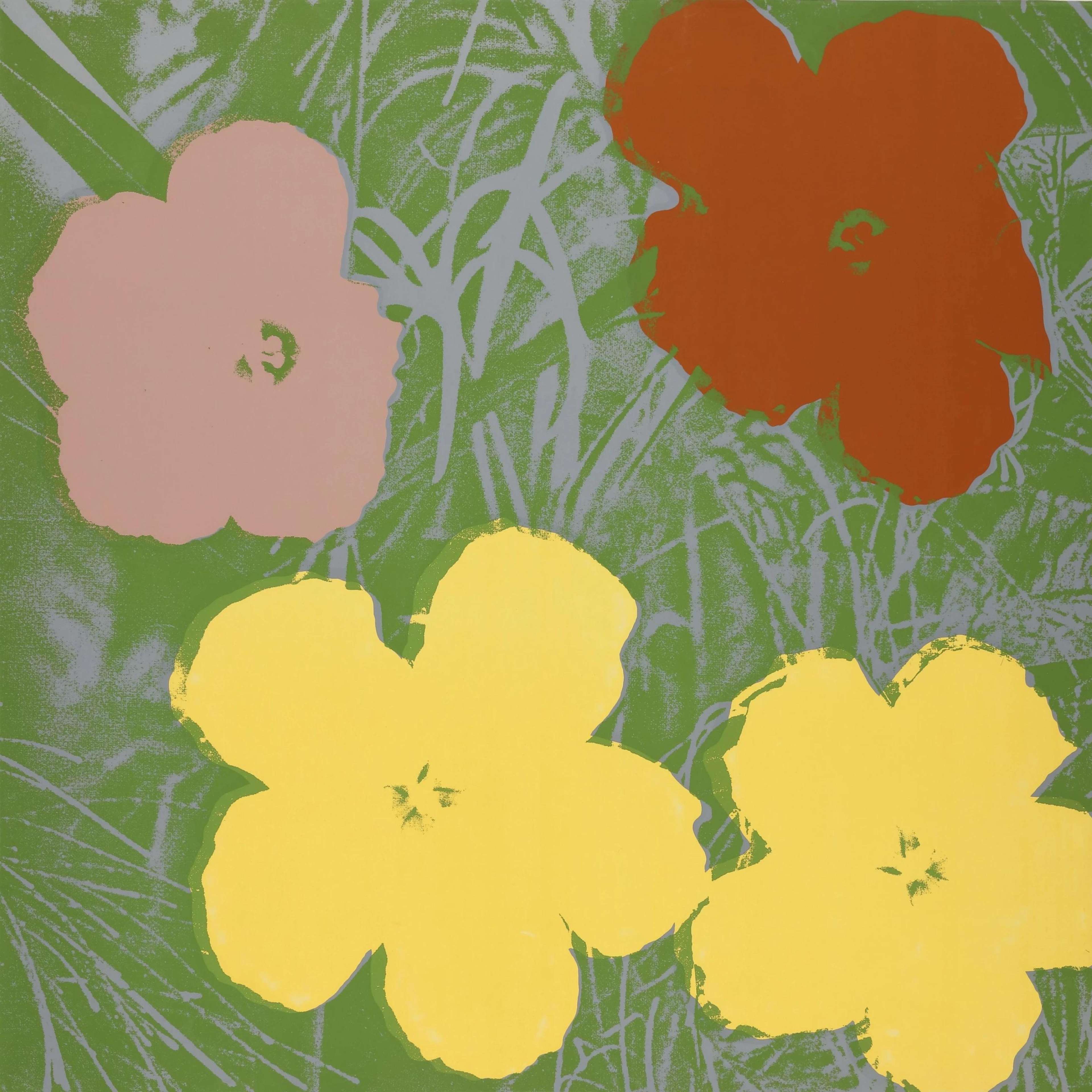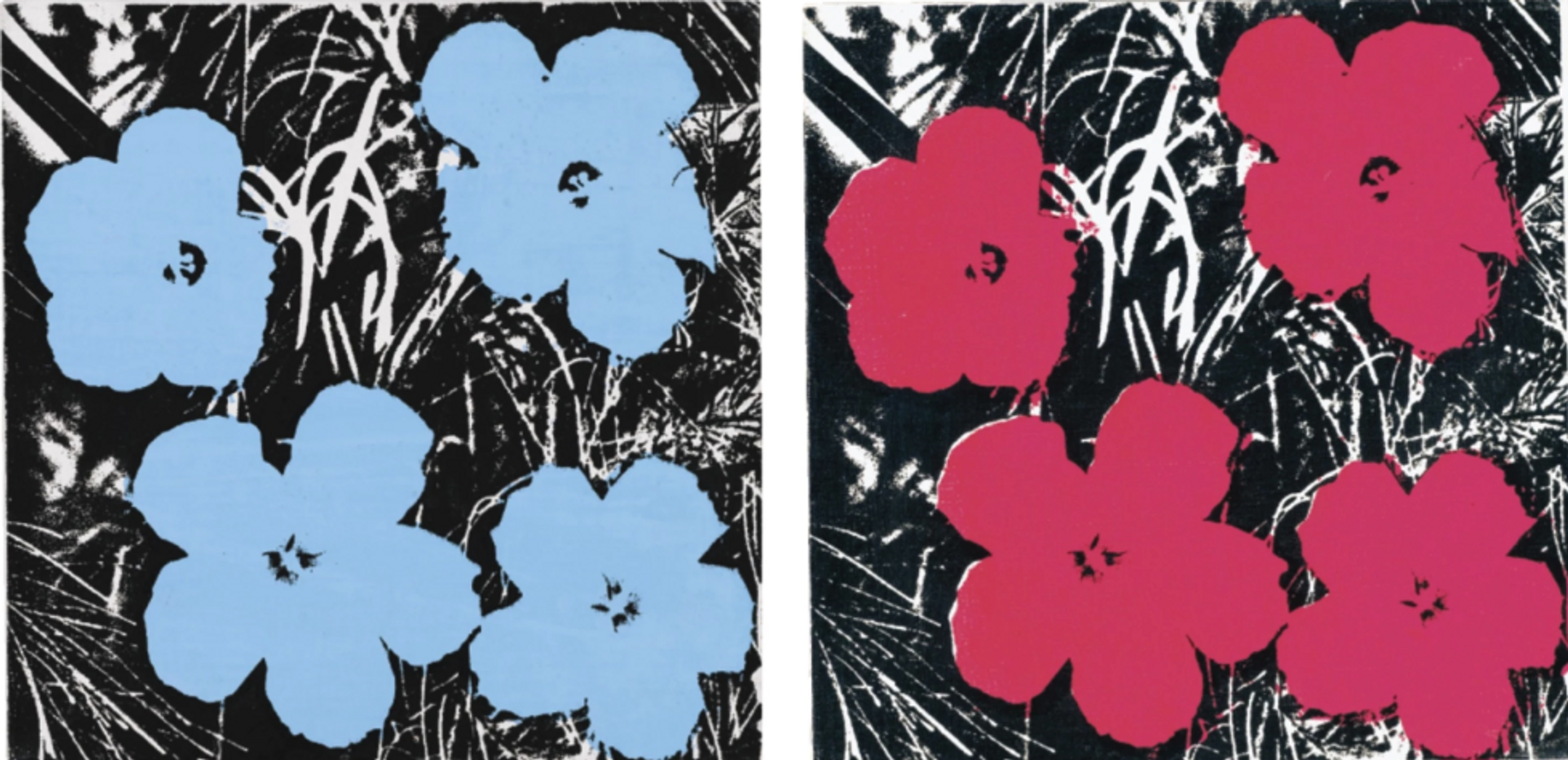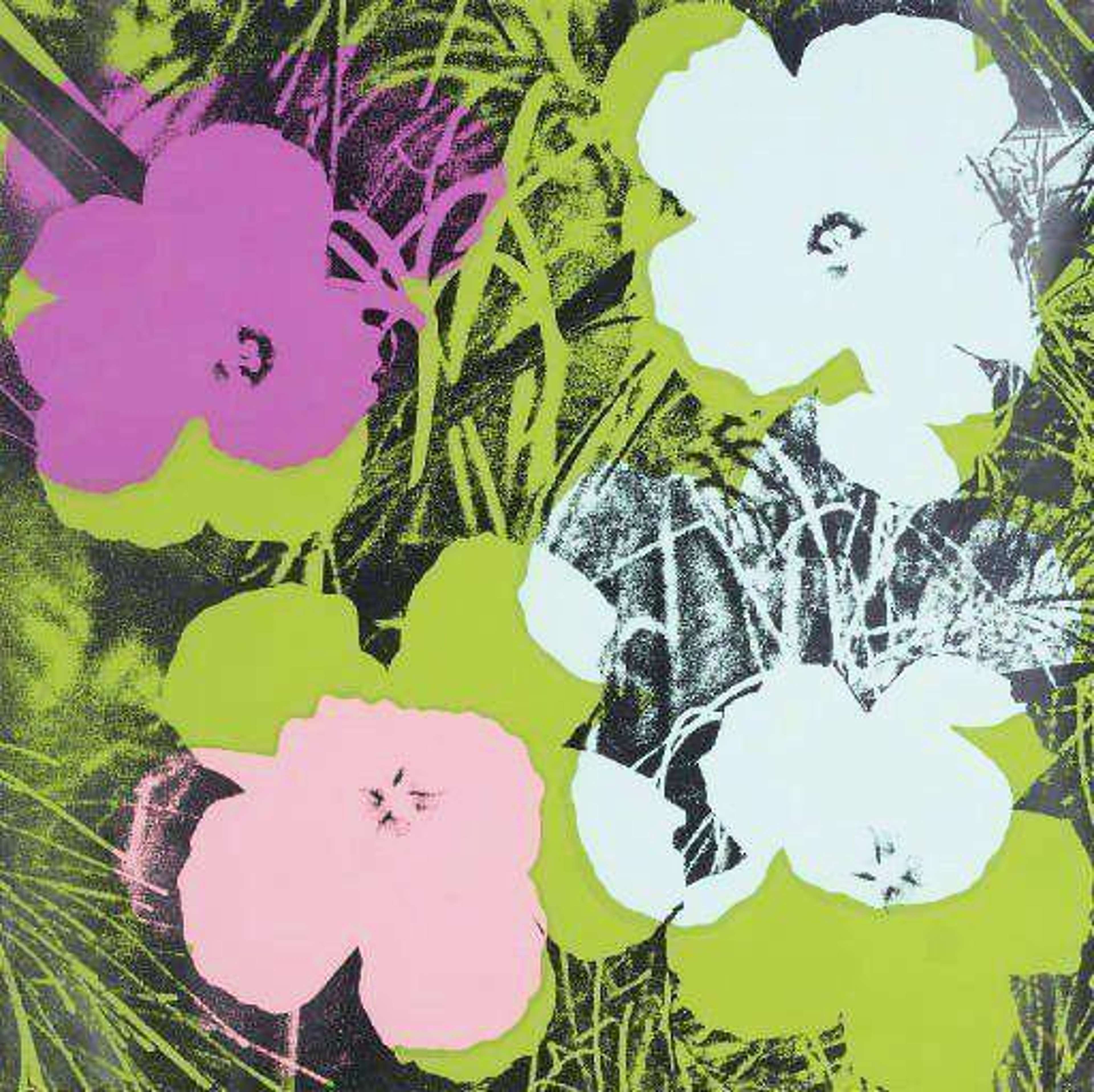 Flowers (F & S 11.72) © Andy Warhol 1970
Flowers (F & S 11.72) © Andy Warhol 1970
Interested in buying or selling
Andy Warhol?

Andy Warhol
487 works
Moving away from portraits, advertisements and politically loaded subjects, the Flowers are some of the most beloved Andy Warhol prints.
To learn more about this series and the history of his floral studies, see our 10 facts here:
Warhol’s Flowers are rooted in art history
 Flowers (F. & S. II.65) © Andy Warhol 1970
Flowers (F. & S. II.65) © Andy Warhol 1970For centuries painters, printmakers, sculptors and draughtsmen have turned their attention to the beauty and wonder of the natural world. From the delicate studies of flowers in Renaissance paintings to the botanical drawings of the 19th century, there is a rich tradition of art imitating nature.
While Warhol may have been inspired by the masters that came before him, he also elegantly departs from this lineage by showing his flowers still living, against a background of a meadow, rather than plucked and artfully arranged as in the still lifes of art history.
What was the inspiration behind Warhol’s Flowers?
 image © Sothebys / Flowers © Andy Warhol 1964
image © Sothebys / Flowers © Andy Warhol 1964The original image for Warhol’s Flowers was a colour photo of seven hibiscus flowers taken by Patricia Caulfield for Modern Photography magazine. However, Warhol’s image is not an exact derivative. As well as converting the image to black and white in order to add his own layers of colour with the silkscreen technique, he also cropped the image to eliminate incomplete flowers and rotated the flower in the upper corner in order to fit the image into a square. A subtle, but effective, change to the composition that made it into the iconic image it is today.
Caulfield sued Warhol for using her image
 Flowers (F. & S. II.70) © Andy Warhol 1970
Flowers (F. & S. II.70) © Andy Warhol 1970The changes Warhol made to Caulfield’s original photograph were evidently not sufficient to avoid copyright law infringement, and in 1966, Caulfield won her lawsuit against Warhol and was awarded US$6,000 in damages.
After copying the logos and packaging of household products, along with press images of celebrities, for so long, it is perhaps surprising that it was a relatively unknown photograph of flowers that was the cause of Warhol’s first plagiarism offence. Interestingly, it was this brush with the law that pushed Warhol toward working with photography himself, producing polaroid portraits and still lifes which would become the source of his silkscreens in years to come.
In Flowers, Warhol shuns naturalism for psychedelic colours
 Flowers (F. & S. II.67) © Andy Warhol 1970
Flowers (F. & S. II.67) © Andy Warhol 1970He turned the grass a vivid electric green and the flowers to bright shades of pink, yellow, orange and blue, all rendered in the characteristic flatness of his silkscreen technique.
In doing so, Warhol reduces the flowers to their most essential elements, eradicating all the detail and depth of the original image in order to create something more akin to the powerful images of cartoons and advertising – not to mention the patterns of 1960s fashion – the artist was constantly referencing throughout his oeuvre.
Flowers is considered Warhol’s most abstract work
 Flowers (F. & S. II.66) © Andy Warhol 1970
Flowers (F. & S. II.66) © Andy Warhol 1970This process of reduction and abstraction meant the species of flowers were rarely recognised as hibiscus at first and many newspapers commenting on the first exhibition misidentified them as anemones, nasturtiums or pansies.
Commenting on the success of the composition art historian Nina Zimmer has written, ‘‘Warhol reduced and radicalised his Flowers to such an extent that the banal subject matter was now transformed into a powerful pictorial concept. The directionless format contributed to this: the pictures can be read in all directions; like an abstract painting, top and bottom, left and right, have been revoked.’’ Warhol apparently delighted in this effect and requested that the works were installed in a random mix of ‘any side up’.
Why did Andy Warhol paint Flowers? How was the series received?
 Flowers (F. & S. II.71) © Andy Warhol 1970
Flowers (F. & S. II.71) © Andy Warhol 1970Warhol’s most notable series before Flowers was entitled Death and Disaster and included such powerful works as Electric Chair and Silver Car Crash, which took inspiration from harrowing images in newspapers and magazines. Perhaps unsurprisingly, these failed to sell to collectors. The artist was persuaded to move onto happier subjects, such as flowers – and this proved a successful move, with the first exhibition at Leo Castelli Gallery of the Flowers series selling out immediately.
Andy Warhol's Flowers has a dark side
 Flowers (F. & S. II.64) © Andy Warhol 1970
Flowers (F. & S. II.64) © Andy Warhol 1970While flowers usually convey beauty and serenity in a painting, these blooms can be strangely dark and melancholic in form and tone. In some versions of the work, the petals are stained red and appear like pools of blood. Given that Warhol began his Flowers series around 1964, the year following JFK's assassination, some have speculated that the series' ominous undercurrent bears some relation to the president's murder. It is certainly not an unlikely interpretation, given that Warhol explored the public figures of both John and Jackie Kennedy, and was not shy of confronting very notorious deaths of public figures, as he did in his Marilyn portraits.
In other versions, the lighter colours only serve to highlight the fragility and ephemeral nature of life as represented by a short moment of blossom. In this way, Warhol’s Flowers, while seeming more traditional and aesthetically appealing than his usual style on the surface, belie a darker message that can also be found in Warhol’s previous work, the Death and Disaster series.
How popular is Warhol’s Flowers series today?
 Flowers (F. & S. II.69) © Andy Warhol 1970
Flowers (F. & S. II.69) © Andy Warhol 1970Today Flowers remains one of Warhol’s most popular series, exhibited widely and reproduced endlessly in ad campaigns, fashion shoots and in popular culture. The juxtaposition of the natural subject and the mechanical means of its reproduction lends the work a playful tension that keeps the viewer coming back for more. Their popularity on the art market is also irrefutable, with portfolios of prints selling for tens of thousands of dollars, while original paintings of the Flowers series have been known to fetch over US$1 million.
Flowers is among Andy Warhol’s most prolific series
 Flowers (F. & S. II.72) © Andy Warhol 1970
Flowers (F. & S. II.72) © Andy Warhol 1970Warhol began creating canvases and prints of Flowers in 48 and 24-inch square formats. He soon moved onto smaller versions – from 15 to 8, to even 5-inch squares – that were more accessible to less established collectors. And while this subject was reproduced hundreds of times in Warhol’s Factory each work retains the pull of the original image.
What other kinds of flowers did Andy Warhol paint?
 Kiku (F. & S. II.309) © Andy Warhol 1983
Kiku (F. & S. II.309) © Andy Warhol 1983As well as his hibiscus series, Warhol would also go on to make works featuring daisies and a variety of Japanese flowers, including chrysanthemums, or kiku.
While, the late 1960s and early ’70s saw Warhol turn back to portraiture and commercialism, he was quick to return to flowers with a series from 1982 entitled Daisy. Here the flower head is cropped from its stem and placed on a block colour background. The colour of the petals also allows for shadow and depth and hand drawn lines have been added to the flower in the style of series such as Love and Reigning Queens.
The following year Fujio Watanuki, a longstanding supporter of the Japanese avant-garde and founder of the Gendai Hanga Center in Tokyo, invited Warhol to create a new body of work inspired by Japanese flowers. The result is Kiku, a stunning series that centres on the chrysanthemum flower, or Kiku in Japanese.
